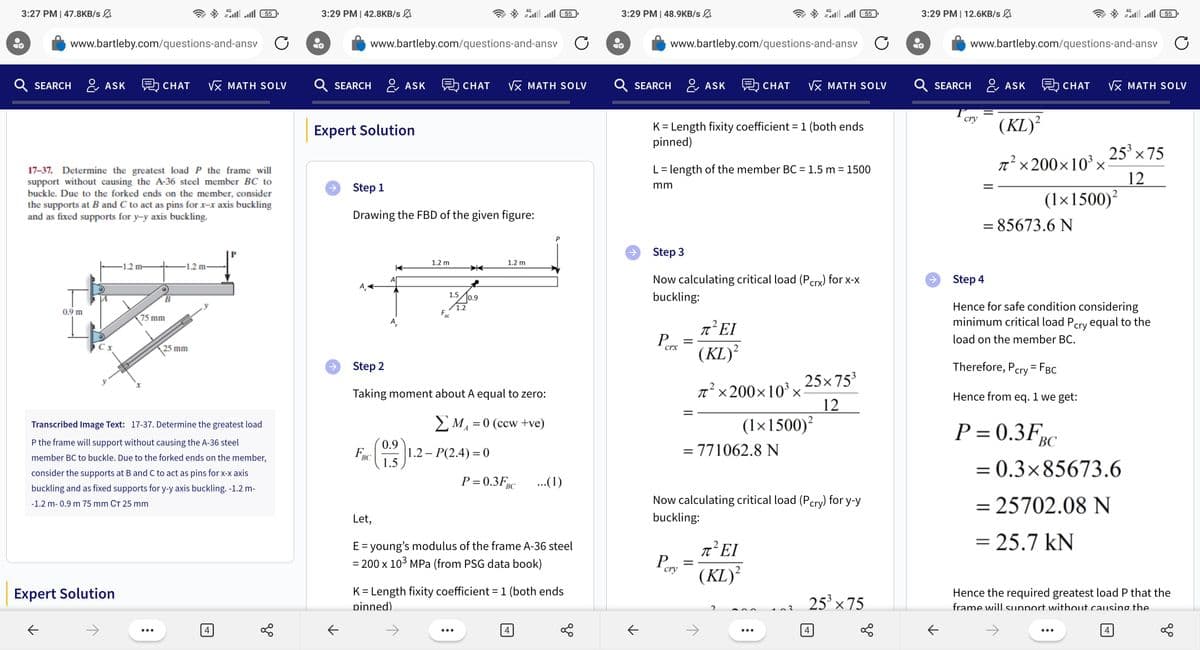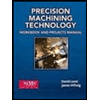Determine the maximum load P that the frame can withstand without bending
Determine the maximum load P that the frame can withstand without bending
Precision Machining Technology (MindTap Course List)
2nd Edition
ISBN:9781285444543
Author:Peter J. Hoffman, Eric S. Hopewell, Brian Janes
Publisher:Peter J. Hoffman, Eric S. Hopewell, Brian Janes
Chapter3: Job Planning, Benchwork, And Layout
Section3.1: Understanding Drawings
Problem 10RQ: List and briefly describe the three types of tolerances used on prints.
Related questions
Question
Determine the maximum load P that the frame can withstand without bending the A992 BC steel part. Due to the split ends of the element, consider that the B and C supports act as joints for buckling on the x - x axis and as fixed supports for buckling on the y-y axis.
Note : A similar problem is already solved on bartl*by.i have attached its screen shot here. You can refer it.

Transcribed Image Text:3:27 PM | 47.8KB/s
www.bartleby.com/questions-and-ansv C
Q SEARCH ASK CHAT VX MATH SOLV
0.9 m
K
17-37. Determine the greatest load P the frame will
support without causing the A-36 steel member BC to
buckle. Due to the forked ends on the member, consider
the supports at B and C to act as pins for x-x axis buckling
and as fixed supports for y-y axis buckling.
Cx
Expert Solution
-1.2 m-
B
4G
75 mm
J
-1.2
55 الله الله
25 mm
Transcribed Image Text: 17-37. Determine the greatest load
P the frame will support without causing the A-36 steel
member BC to buckle. Due to the forked ends on the member,
consider the supports at B and C to act as pins for x-x axis
buckling and as fixed supports for y-y axis buckling. -1.2 m-
-1.2 m- 0.9 m 75 mm CT 25 mm
go
3:29 PM | 42.8KB/s
SEARCH
个
Expert Solution
←
www.bartleby.com/questions-and-ansv C
ASK
FBC
Let,
Step 1
Drawing the FBD of the given figure:
0.9
1.5
1.2 m
F
1.5
BC
CHAT √x MATH SOLV
1.2
0.9
4G
Step 2
Taking moment about A equal to zero:
ΣM₁ = 0 (ccw+ve)
A
55 ) الله الله
1.2 m
1.2 - P(2.4) = 0
P=0.3FBC ...(1)
E = young's modulus of the frame A-36 steel
= 200 x 10³ MPa (from PSG data book)
4
K = Length fixity coefficient = 1 (both ends
pinned)
3:29 PM | 48.9KB/s
SEARCH
个
www.bartleby.com/questions-and-ansv
K = Length fixity coefficient = 1 (both ends
pinned)
P
L = length of the member BC = 1.5 m = 1500
mm
Step 3
Now calculating critical load (Pcrx) for x-x
buckling:
crx
P
=
cry
ASK 即CHAT √x MATH SOLV
2 EI
=
π᾽ΕΙ
(KL)²
π²×200×10³ ×
= 771062.8 N
4G
Now calculating critical load (Pcry) for y-y
buckling:
(1×1500)²
π᾽ΕΙ
(KL)²
●●●
25×75³
12
3
55
25³ ×75
4
3:29 PM | 12.6KB/s
个
←
Q SEARCH ASK CHAT √x MATH SOLV
www.bartleby.com/questions-and-ansv C
cry
(KL)²
π² ×200×10³ ×
2
= 85673.6 N
(1x1500)²
Therefore, Pcry = FBC
Hence from eq. 1 we get:
P=0.3F
55 الله الله
4G
Step 4
Hence for safe condition considering
minimum critical load Pcry equal to the
load on the member BC.
25³ ×75
12
BC
= 0.3x85673.6
= 25702.08 N
= 25.7 kN
●●●
Hence the required greatest load P that the
frame will support without causing the

Transcribed Image Text:25 mm
35 mm
m
1m
m
Expert Solution
This question has been solved!
Explore an expertly crafted, step-by-step solution for a thorough understanding of key concepts.
Step by step
Solved in 2 steps with 2 images

Knowledge Booster
Learn more about
Need a deep-dive on the concept behind this application? Look no further. Learn more about this topic, mechanical-engineering and related others by exploring similar questions and additional content below.Recommended textbooks for you

Precision Machining Technology (MindTap Course Li…
Mechanical Engineering
ISBN:
9781285444543
Author:
Peter J. Hoffman, Eric S. Hopewell, Brian Janes
Publisher:
Cengage Learning

Welding: Principles and Applications (MindTap Cou…
Mechanical Engineering
ISBN:
9781305494695
Author:
Larry Jeffus
Publisher:
Cengage Learning

Precision Machining Technology (MindTap Course Li…
Mechanical Engineering
ISBN:
9781285444543
Author:
Peter J. Hoffman, Eric S. Hopewell, Brian Janes
Publisher:
Cengage Learning

Welding: Principles and Applications (MindTap Cou…
Mechanical Engineering
ISBN:
9781305494695
Author:
Larry Jeffus
Publisher:
Cengage Learning